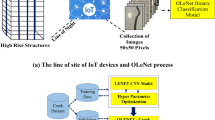Abstract
Tunnel cracks on concrete surfaces are one of the earliest indicators of degradation, and if not promptly treated, they could result in full closure of an entire infrastructure or even worse in a structural failure of it. Visual inspection, carried out by trained operators, is still the most commonly used technique, and according to the literature, automatic assessment systems are arguably expensive and still rely on old image processing techniques, precluding the possibility to afford a large quantity of them for a high-frequency monitoring. So, this article proposes a low cost, automatic detection system that exploits deep convolutional neural network (CNN) architectures for identifying cracks in tunnels relying only on low-resolution images. The trained model is obtained with two different methods: a custom CNN trained from scratch and a retrained 48-layer network, using supervised learning and transfer learning, respectively. Both architectures have been trained and tested with an image database acquired with the first prototype of the video acquisition system.
Access this chapter
Tax calculation will be finalised at checkout
Purchases are for personal use only
Similar content being viewed by others
References
Deng, J., Dong, W., Socher, R., Li, L. J., Li, K., Fei-Fei, L.: ImageNet: a large-scale hierarchical image database. In: 2009 IEEE Conference on Computer Vision and Pattern Recognition, pp. 248–255. IEEE, Miami (2009)
Simard, P.Y., Steinkraus, D., Platt, J.C.: Best practices for convolutional neural networks applied to visual document analysis. In: ICDAR, vol. 3, pp. 958–962. IEEE Computer Society (2003)
Srivastava, N., Hinton, G., Krizhevsky, A., Sutskever, I., Salakhutdinov, R.: Dropout: a simple way to prevent neural networks from overfitting. J. Mach. Learn. Res. 15(1), 1929–1958 (2014)
Yamaguchi, T., Nakamura, S., Hashimoto, S.: An efficient crack detection method using percolation-based image processing. In: 2008 3rd IEEE Conference on Industrial Electronics and Applications, pp. 1875–1880. IEEE (2008)
Qi, D., Liu, Y., Wu, X., Zhang, Z.: An algorithm to detect the crack in the tunnel based on the image processing. In: 2014 Tenth International Conference on Intelligent Information Hiding and Multimedia Signal Processing, pp. 860–863. IEEE (2014)
Stent, S., Gherardi, R., Stenger, B., Soga, K., Cipolla, R.: Visual change detection on tunnel linings. Mach. Vis. Appl. 27(3), 319–330 (2014)
Laurent, J., Fox-Ivey, R., Dominguez, F.S., Garcia, J.A.R.: Use of 3D scanning technology for automated inspection of tunnels. In: Proceedings of the World Tunnel Congress, pp. 1–10 (2014)
Liu, Z., Suandi, S.A., Ohashi, T., Ejima, T.: Tunnel crack detection and classification system based on image processing. In: Machine Vision Applications in Industrial Inspection X. International Society for Optics and Photonics, vol. 4664, pp. 145–152 (2002)
Stent, S.A.I., Girerd, C., Long, P.J.G., Cipolla, R.: A low-cost robotic system for the efficient visual inspection of tunnels. In: ISARC Proceedings of the International Symposium on Automation and Robotics in Construction, vol. 32, p. 1. IAARC Publications (2015)
Protopapadakis, E., Makantasis, K., Kopsiaftis, G., Doulamis, N., Amditis, A.: Crack identification via user feedback, convolutional neural networks and laser scanners for tunnel infrastructures. VISIGRAPP/VISAPP 4, 725–734 (2016)
Nair, V., Hinton, G.E.: Rectified linear units improve restricted Boltzmann machines. In: Proceedings of the 27th International Conference on Machine Learning, pp. 807–814 (2010)
Author information
Authors and Affiliations
Corresponding author
Editor information
Editors and Affiliations
Rights and permissions
Copyright information
© 2021 The Editor(s) (if applicable) and The Author(s), under exclusive license to Springer Nature Singapore Pte Ltd.
About this chapter
Cite this chapter
Mazzia, V., Daneshgaran, F., Mondin, M. (2021). Use of Deep Learning for Automatic Detection of Cracks in Tunnels. In: Esposito, A., Faundez-Zanuy, M., Morabito, F., Pasero, E. (eds) Progresses in Artificial Intelligence and Neural Systems. Smart Innovation, Systems and Technologies, vol 184. Springer, Singapore. https://doi.org/10.1007/978-981-15-5093-5_9
Download citation
DOI: https://doi.org/10.1007/978-981-15-5093-5_9
Published:
Publisher Name: Springer, Singapore
Print ISBN: 978-981-15-5092-8
Online ISBN: 978-981-15-5093-5
eBook Packages: Intelligent Technologies and RoboticsIntelligent Technologies and Robotics (R0)




